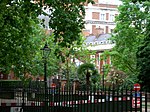Kensington Palace

Kensington Palace is a royal residence set in Kensington Gardens, in the Royal Borough of Kensington and Chelsea in London, England. It has been a residence of the British royal family since the 17th century, and is currently the official London residence of the Duke and Duchess of Cambridge, the Duke and Duchess of Gloucester, the Duke and Duchess of Kent, and Prince and Princess Michael of Kent. Today, the State Rooms are open to the public and managed by the independent charity Historic Royal Palaces, a nonprofit organisation that does not receive public funds. The offices and private accommodation areas of the Palace remain the responsibility of the Royal Household and are maintained by the Royal Household Property Section. The palace also displays many paintings and other objects from the Royal Collection.
Excerpt from the Wikipedia article Kensington Palace (License: CC BY-SA 3.0, Authors, Images).Kensington Palace
Palace Avenue, London South Kensington (Royal Borough of Kensington and Chelsea)
Geographical coordinates (GPS) Address Phone number External links Nearby Places Show on map
Geographical coordinates (GPS)
| Latitude | Longitude |
|---|---|
| N 51.505277777778 ° | E -0.18833333333333 ° |
Address
Kensington Palace
Palace Avenue
W8 4PX London, South Kensington (Royal Borough of Kensington and Chelsea)
England, United Kingdom
Open on Google Maps







